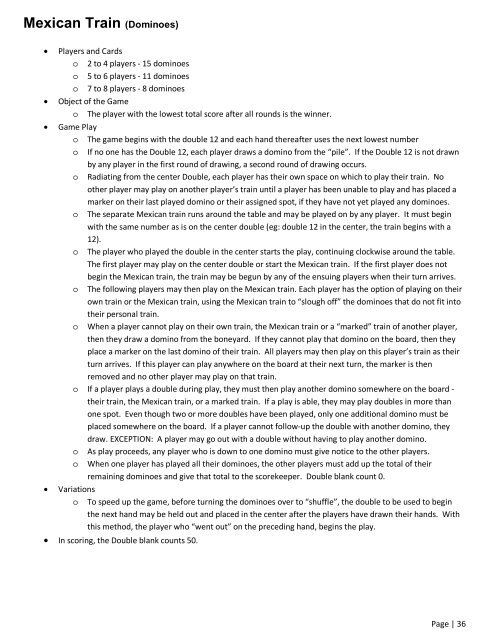Create successful ePaper yourself
Turn your PDF publications into a flip-book with our unique Google optimized e-Paper software.
Mexican Train (Dominoes)<br />
�� Players and <strong>Card</strong>s<br />
o 2 to 4 players - 15 dominoes<br />
o 5 to 6 players - 11 dominoes<br />
o 7 to 8 players - 8 dominoes<br />
�� Object of the <strong>Game</strong><br />
o <strong>The</strong> player with the lowest total score after all rounds is the winner.<br />
�� <strong>Game</strong> Play<br />
o <strong>The</strong> game begins with the double 12 and each hand thereafter uses the next lowest number<br />
o If no one has the Double 12, each player draws a domino from the “pile”. If the Double 12 is not drawn<br />
by any player in the first round of drawing, a second round of drawing occurs.<br />
o Radiating from the center Double, each player has their own space on which to play their train. No<br />
other player may play on another player’s train until a player has been unable to play and has placed a<br />
marker on their last played domino or their assigned spot, if they have not yet played any dominoes.<br />
o <strong>The</strong> separate Mexican train runs around the table and may be played on by any player. It must begin<br />
with the same number as is on the center double (eg: double 12 in the center, the train begins with a<br />
12).<br />
o <strong>The</strong> player who played the double in the center starts the play, continuing clockwise around the table.<br />
<strong>The</strong> first player may play on the center double or start the Mexican train. If the first player does not<br />
begin the Mexican train, the train may be begun by any of the ensuing players when their turn arrives.<br />
o <strong>The</strong> following players may then play on the Mexican train. Each player has the option of playing on their<br />
own train or the Mexican train, using the Mexican train to “slough off” the dominoes that do not fit into<br />
their personal train.<br />
o When a player cannot play on their own train, the Mexican train or a “marked” train of another player,<br />
then they draw a domino from the boneyard. If they cannot play that domino on the board, then they<br />
place a marker on the last domino of their train. All players may then play on this player’s train as their<br />
turn arrives. If this player can play anywhere on the board at their next turn, the marker is then<br />
removed and no other player may play on that train.<br />
o If a player plays a double during play, they must then play another domino somewhere on the board -<br />
their train, the Mexican train, or a marked train. If a play is able, they may play doubles in more than<br />
one spot. Even though two or more doubles have been played, only one additional domino must be<br />
placed somewhere on the board. If a player cannot follow-up the double with another domino, they<br />
draw. EXCEPTION: A player may go out with a double without having to play another domino.<br />
o As play proceeds, any player who is down to one domino must give notice to the other players.<br />
o When one player has played all their dominoes, the other players must add up the total of their<br />
remaining dominoes and give that total to the scorekeeper. Double blank count 0.<br />
�� Variations<br />
o To speed up the game, before turning the dominoes over to “shuffle”, the double to be used to begin<br />
the next hand may be held out and placed in the center after the players have drawn their hands. With<br />
this method, the player who “went out” on the preceding hand, begins the play.<br />
�� In scoring, the Double blank counts 50.<br />
Page | 36


